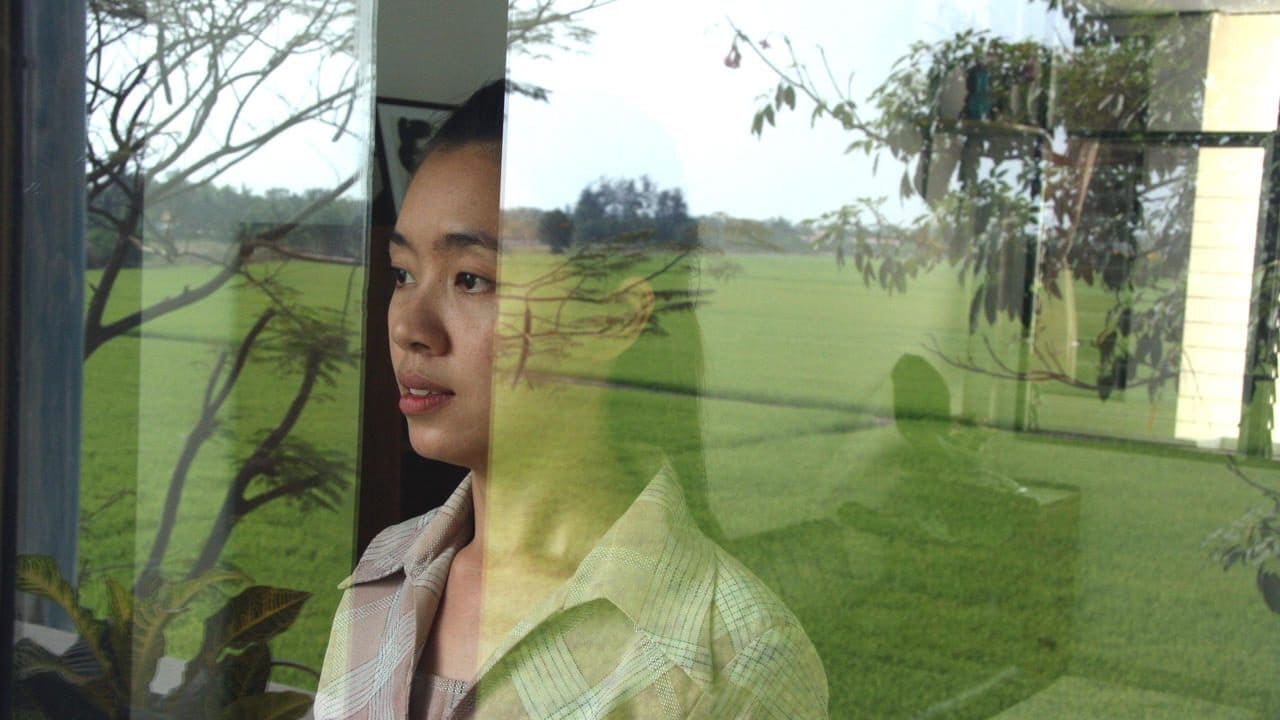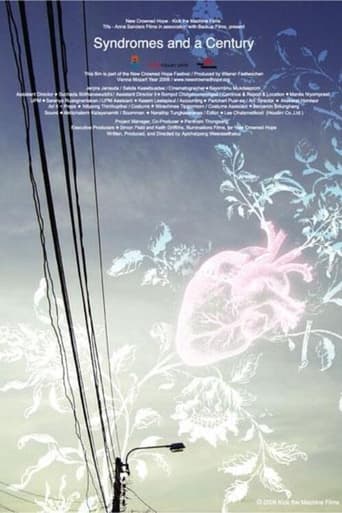

Vague talk of art nine times out of ten will miss the whole point. Critics will enumerate a few themes, but that is repeating words, knowing one word instead of ten things. The main thing is that here we have a filmmaker who knows what it all is out there, or better said: knows how to sculpt currents of life with a clarity that is neither misty-eyed nor cynical, that is both unwavering gaze of the present and mental awareness of broader cycles. Let's see what is all that. The film is split in two halves, both centered around a hospital with recurring characters coming and going. The first half is an idyllic countryside reverie with lush tropical foliage looming outside the hospital windows; it is a love song wafting through the quiet summer night, the sound of crickets carried by the breeze, stories of climbing mango trees and reincarnation, sunlight over green pastures. Inside this part there is another story of denied love but look how gentle the emotional handling; it ends with laughter, with no one needlessly wounded or wallowing in misery, with no judgement and no one's soul exposed except a tiny corner tenderly to us. So the first part is unspooling some lovely mood, simple so you may not think much of the film at this point. Except we have a second part, again in a hospital, repeats the opening shot of the film but now the pov has been reversed—with us 'looking back' at what was being looked at in the first scene. There are several shifts in this second part. Some obvious ones, in time and mood, the hospital now is modern, the mood is sterile, the jungle out the window is now the concrete boom of the big city. A little less obviously: we now miss the rustic gift of wrapped crispy pork, the small talk of musical dreams with the dentist, no one tells stories about mango trees or reincarnation anymore. There is no love song. Traffic instead of crickets.To emphasize this bizarre new landscape of life, there is a sequence starting with when we see a legless man crouching on the floor, a bizarre sight intentionally shot this way to jar. People are being fitted with artificial limbs in the basement, and the imagery though now it makes sense is still depressing by contrast to earlier. Now there's carbon monoxide poisoning.However, other things have not changed. The stone statue of the sitting Buddha is in the same place. The old Buddhist monk still has funny dreams with chicken, still swaps medical advice for herbs that supposedly sooth confused mind. You may appreciate that his memory is better now. The best part is at the level of perception of things. Until the second segment with the drastic shift ahead, we don't know all that tropical bliss and boredom is going to be in the past. Suddenly we have memories of a past life, colored as more pure because we recall it as more pure. It is a bit of a mystery just how this has happened, in physical terms, how the two worlds fit together, which is for the better; this is not to be reasoned with, the insight is of emotional intellect.By this I mean a specific thing, a shift in watching. Now the first part seems more pure, the modern second part more depressing which makes the contrast a little mawkish and the film slightly contrived. But that is in large part in the eye.If you look closer, in the present segment people are no more sullen or hurried, as we'd think normal to show in modern life, than at first. The surrounding world has changed of course, and that does affect the experience of living. Whereas there used to be clean riverwater to bathe one's broken parts in, now the old woman has to conjure the cleansing illusion of healing water. Isn't cinema nothing but a cleansing illusion? It can only have as much effect, as much depth as you let it. This scene is key. Faced with the old crone, the boy does what? Walks away suspicious of the healing effect. Next to traffic and carbon monoxide poisoning, now there is cynicism. So if you, similarly, turn your back on the healing promise of the film and walk away with just an artful assertion of the effects of modernization, you miss the whole reason behind this.It all ends with two unforgettable shots of this cinematic healing illusion in actual effect; everything sucked into the roaring void but that is not the end, the parting shot of public gymnastics in a park shows a renewal and zest for it all to start again, an absolutely marvelous moment.So we've had some expansion of our awareness in the first part because of the freeflow and not knowing where it goes, colored by memory in the second part and contraction as the mind points out logical contrasts between past and present, setting limits to vision because suddenly we define the present by what it's not, the 'purer' past.Now emptying ourselves of all that in the first of the two shots (samadhi), this last shot rings loud and clear, restoring the world to broader dimensions. It is one of the most transcendent moments in film, equal to the dance scene of another Asian film, Sharasojyu.In both cases it is not the shot itself, it is the placement, opening our eyes to it after all we've seen. There are no words, no conventional wisdom for the mind to latch onto except breathing in the air of that one exuberant moment of people.This is what the Buddhist know and cultivate in meditation as prajna or intuitive wisdom, understanding the one root beneath the myriad branches of illusion.Something to meditate upon.
... View MoreIf only this dream sequence of a film came with a frame, a few moments of lucid guidance. A narrator, even for a brief opening and perhaps an explanatory note on the shift from rural Thailand to urban?Without a background prep course, we are left wandering. We are told by reviewers that this is a film about "Joe's" parents, his memories. Oh? Where? Not in the film. Not unless some lengthy Thai passage wasn't translated.Please, Apichatpong, just a hint and the help of structure. It wouldn't have harmed the feel, the mood, the effect, in any way.Are the two contrasting sections of the film, rural to urban, concurrent or a gap in time?Some scenes, disassociated as they may be, are marvelous. The industrial process room, with a snakelike suction tube that would have done Dali proud. The steam, the fumes, whatever the smoky substance, swirling amid the machinery, I could smell the metal in the air.We are also told by other reviewers that it's one of the Four Best films of the past decade in one poll and THE best in a poll of critics associated with the prestigious Toronto Film Festival.Really? You can't be serious.What it truly is? A film of beauty, of quiet, of sly humor, reflection, and a soundtrack of subdued accompaniment that seems to invite introspection in the viewer.That's not all that bad, if you ask me. But we need a Sherpa beyond the simple edits.If you do some research you'll find that the film was prohibited from exhibition in Thailand. Four scenes the censors thought objectionable, including a long, yet somewhat passive kiss and the sight of a monk playing guitar.Strange, these moral critiques coming from country that for decades allowed its capital to become the brothel of the world.I fear some of the reviews are thus political. And certainly I can't support censorship. But let's get a grip on the difference between support for the filmmaker and sainthood.
... View MoreI have read several reviews and found this very amusing. Actually I have seen this movie and couldn't figure out what so artistic about it. This is more like Andy Warhol shooting a film about a man sleeping eight hours on screen. Warhol considers this art. Now this film is almost similar. If you want art take a lesson from the real master.Someone did mention Kubrick somewhere, don't compare him to this guy. It's a different story. Back to art, anyone who is a fan of Kurosawa? How about Fellini? Also there is Gus Vant Sant. Don't tell me this film can be compared to the art of these true artists.This (Sang Sattawat) is to me a real sleep movie. ZZZZZZZZZZZZZZ
... View MoreI never had a dentist sing to me while he worked. It's just as well as I usually fall asleep. It is just one of the strange things that happen in this rural hospital. But the stories and the characters seem tangential. They focus is on the sets. Whether the hospital, the farmer's market, or the orchid farm; the sets seem to be what Apichatpong Weerasethakul is emphasizing.People may be talking or singing, but the camera is on a window with the sun shining through, and it stays there for a long time.There is no continuity. Scenes shift aimlessly with no apparent purpose. You almost feel like you are watching a Godfrey Reggio film with some dialog.The film suddenly shifts to a city hospital, and we see some of the same scenes repeated. Where the first half was very feminine, the second half takes on a masculine tone.The dentist doesn't sing, he has an assistant, and everything is sterile. The doctors seem more matter-of-fact, almost uncaring.One thing is consistent, and that is a large white Buddha. It sits on the ground of both stories.After a long shot of a hallway, the screen goes black leaving you wondering. It is a true art film for those who appreciate what a filmmaker can do and who are not upset by the lack of story.A Zen kōan.
... View More